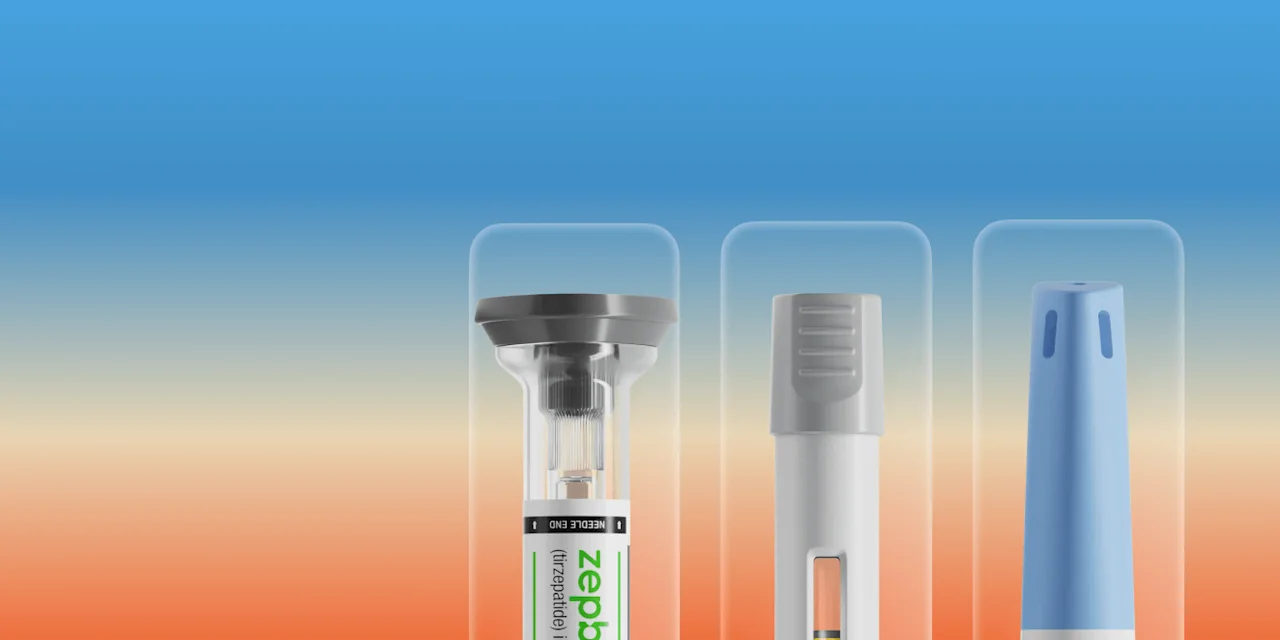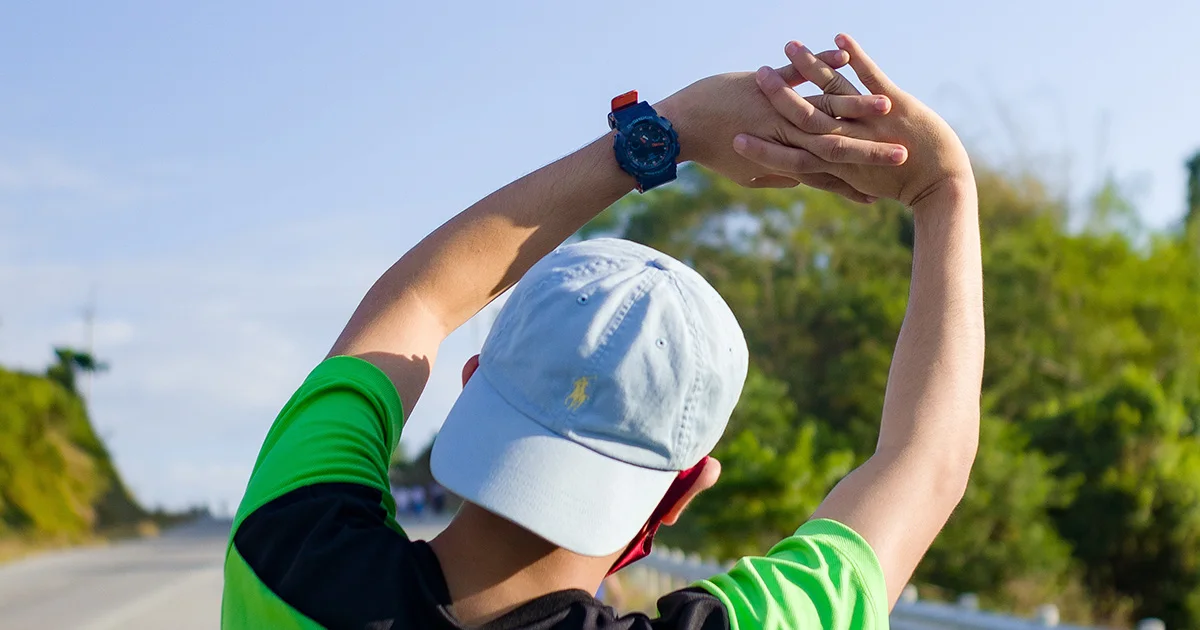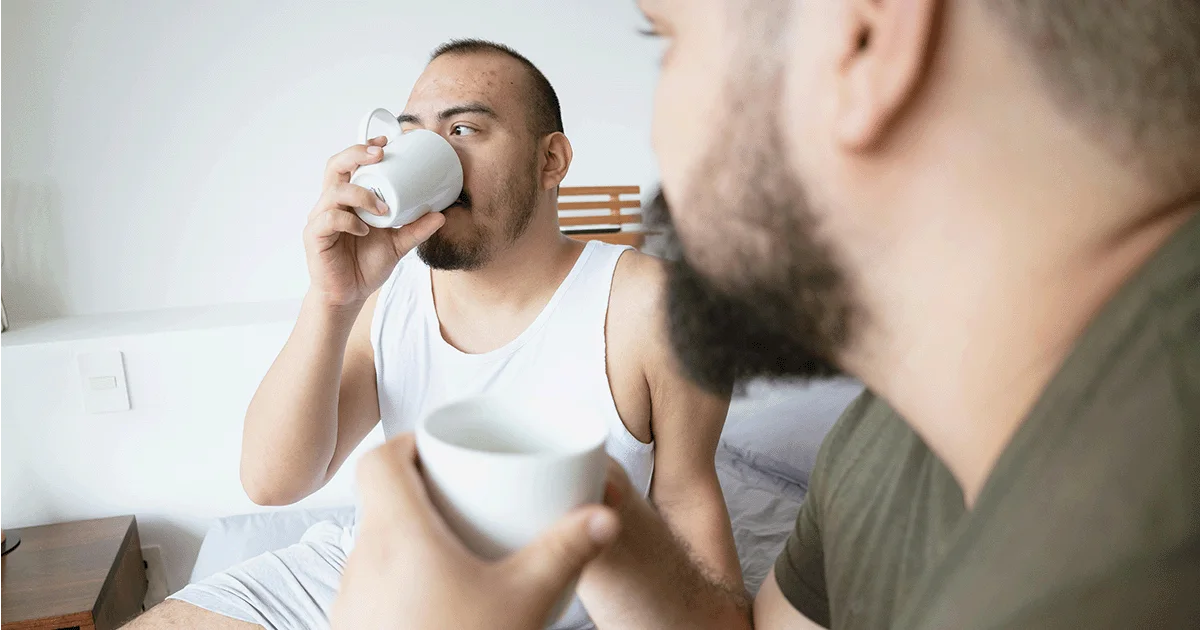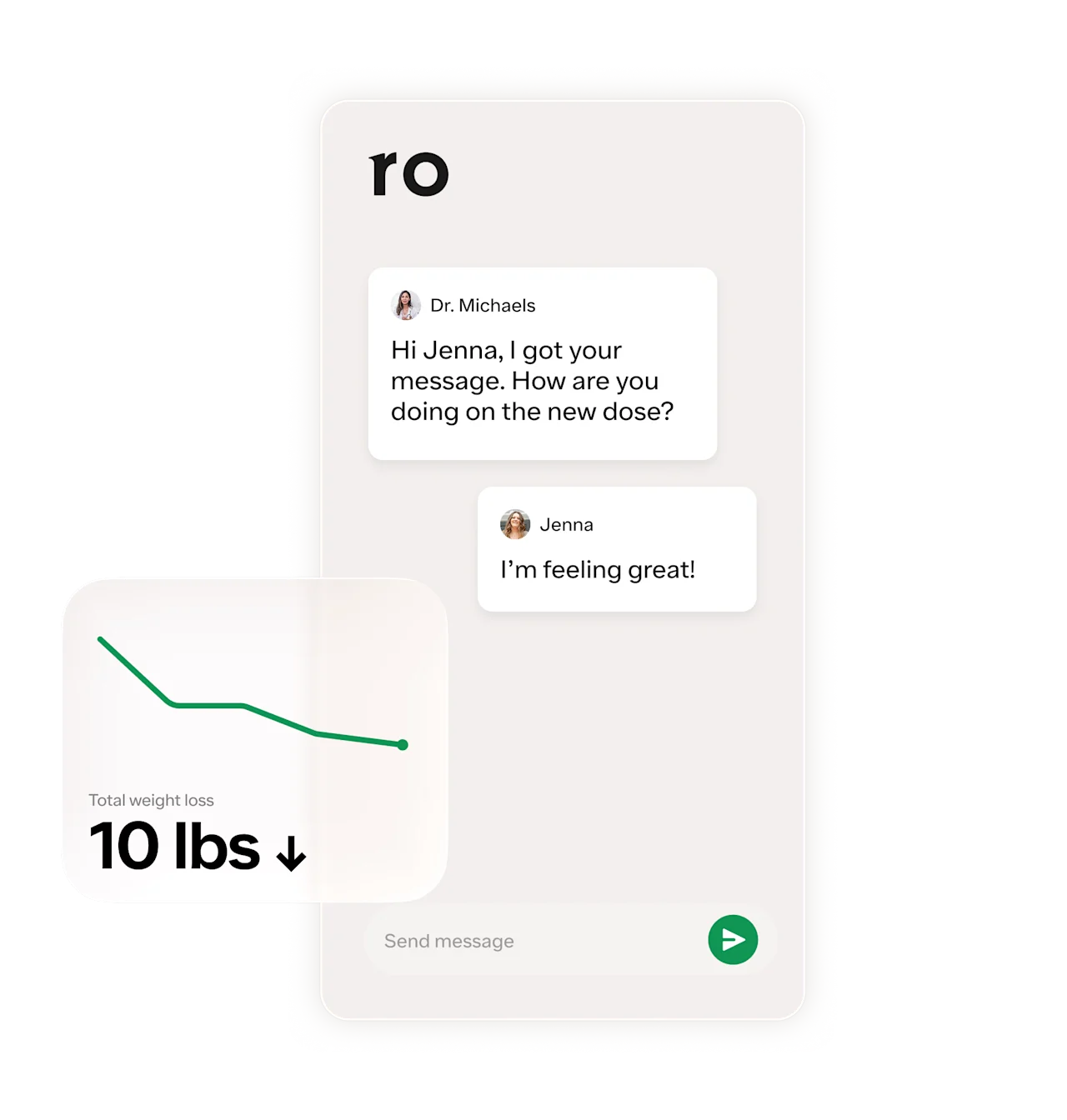Key takeaways
GLP-1 patches aren’t FDA-approved and don’t contain real GLP-1 medications. Currently, all FDA-approved GLP-1 medications are injectable or oral, not topical.
Weight loss patches can contain stimulants or herbal ingredients, such as green tea extract, but there’s little proof that they work for weight loss.
Lifestyle changes (like eating a balanced diet and exercising regularly) and prescription GLP-1 medications (if appropriate) can be more effective options for weight loss.
Here's what we'll cover
Key takeaways
GLP-1 patches aren’t FDA-approved and don’t contain real GLP-1 medications. Currently, all FDA-approved GLP-1 medications are injectable or oral, not topical.
Weight loss patches can contain stimulants or herbal ingredients, such as green tea extract, but there’s little proof that they work for weight loss.
Lifestyle changes (like eating a balanced diet and exercising regularly) and prescription GLP-1 medications (if appropriate) can be more effective options for weight loss.
GLP-1 medications like semaglutide have changed the landscape of obesity treatment. These prescription drugs mimic a natural hormone (GLP-1) that regulates blood sugar and appetite. Studies show these medications can lead to meaningful weight loss in people with overweight or obesity. And now, products like GLP-1 patches seem to be hitting the market.
These over-the-counter (OTC) adhesive patches are marketed as a convenient, needle-free way to deliver GLP-1-like effects without a prescription. But do they really contain GLP-1, or is the name misleading? And can they actually help you lose weight? Here's what the science and experts say.
What are GLP-1 patches?
GLP-1 patches are marketed as weight loss tools that you stick onto your skin, usually on your upper arm or torso. They claim to gradually release ingredients through the skin to support weight loss over time.
Some of these patches directly mention GLP-1 or semaglutide in their marketing; others claim that their ingredients mimic the effects of prescription GLP-1s, similar to other supposed slim-down products like weight loss gummies or pink Himalayan salt. This messaging can make it seem like you’re getting the same benefits as GLP-1s like Wegovy or Zepbound, which are approved by the US Food and Drug Administration (FDA), but the marketing is extremely misleading.
“Right now, there’s no FDA-approved GLP-1 patch,” says Raj Dasgupta, MD, associate professor of clinical medicine at the University of California, Riverside School of Medicine. “The GLP-1 medications we know help with weight loss, like semaglutide, are given as injections or pills, not patches.”
In reality, so-called “GLP-1 patches” are usually just infused with herbal ingredients or natural stimulants that have limited or no clinical evidence for effectiveness, especially when delivered through the skin, Dr. Dasgupta says.
Do GLP-1 patches actually contain GLP-1s?
No, GLP-1 patches do not contain GLP-1 — and neither do FDA-approved GLP-1 medications, for that matter. FDA-approved GLP-1 drugs are injections or oral medications that are designed to mimic the effects of GLP-1, a naturally occurring hormone that regulates blood sugar and appetite in the body.
And there’s a reason these medications are only FDA-approved as injections or pills: Their active ingredients aren’t easily absorbed through the skin.
“The molecular structure of GLP-1 peptides is large, hydrophilic, and electrically charged, which severely limits the ability of the molecule to pass the outer layer of the skin and enter the bloodstream,” says Edwin Davila, DO, resident physician and obesity medicine expert on the scientific council for the National Academy of Sports Medicine. These drugs also degrade quickly unless kept refrigerated, making delivery through a patch even more impractical.
In short, regarding the patches: “There’s no solid science to back them up,” Dr. Dasgupta says. “I’d be very cautious about products like that.”
Common ingredients in GLP-1 patches
Most GLP-1 patches or weight loss patches contain a mix of herbs and stimulants, often the same ingredients found in pills and other supplements that are marketed as appetite suppressants or fat burners, Dr. Davila says. However, most of these ingredients have only been studied in pill or capsule form, not as patches.
In fact, there’s little to no evidence that the skin effectively delivers these ingredients to your body, Dr. Davila says. Still, many of these compounds continue to appear in weight loss products of all kinds.
With that in mind, here are some of the most common ingredients found in weight loss patches.
Green tea extract
Green tea (and other herbal teas like yerba mate) contains catechins and caffeine — two compounds that are thought to modestly boost metabolism and fat oxidation. One older study showed that small amounts of catechins and caffeine can be delivered through the skin using green tea extract adhesive patches. But the absorption rate was extremely low — about 0.1% of the dose after 24 hours. That’s similar to oral absorption in rats, but far lower than typical oral doses in humans.
So, while skin-based delivery is technically possible, there’s no strong or recent evidence that it produces meaningful fat-burning effects in real-world use.
Garcinia cambogia
This tropical fruit contains hydroxycitric acid, which is thought to reduce appetite and inhibit fat production, Dr. Davila says. In one trial, adults with overweight or obesity who took 500 mg of garcinia cambogia and 500 mg of glucomannan (a type of fiber) twice daily for six months experienced modest drops in body weight and fat mass.
However, the study participants weren’t randomly assigned to different groups, which makes it harder to rule out other factors that could have influenced the results. These results were also from oral supplements, and it’s unlikely skin patches could create a similar effect. Furthermore, garcinia cambogia was not studied alone in the trial. It’s possible the glucomannan played a significant role in contributing to the results, especially since it’s known that increasing fiber in your diet can help with weight management.
Guarana
Guarana, a plant from the Amazon, contains high levels of caffeine and is sometimes added to energy supplements, according to a review. Caffeine may modestly suppress appetite or increase energy expenditure.
That same review of animal studies found that guarana powder may improve metabolic markers linked to obesity. However, these findings are based on oral dosing in animals, not humans. There’s also no research to show guarana’s effects via skin patches.
Bitter orange (synephrine)
This citrus extract contains synephrine, a naturally occurring stimulant often found in weight loss products. However, one review found that synephrine-containing oral supplements were not linked to weight loss. And since these supplements were studied orally, where absorption is higher, it’s even less likely that a patch delivering synephrine through the skin — which absorbs substances much less efficiently — would be effective.
These supplements were also associated with increases in heart rate and blood pressure — especially when taken alongside caffeine — raising concerns about potential cardiovascular risks.
L-carnitine
L-carnitine is an amino acid that transports fatty acids into cells to be used for energy. A review found that L-carnitine supplementation by mouth may slightly reduce body weight and fat mass in people with overweight and obesity. However, there’s currently no evidence to support its absorption or effectiveness when delivered through the skin.
Do GLP-1 patches work?
So far, there’s no scientific evidence that a transdermal sticker — whether labeled as a GLP-1 patch, weight loss patch, or otherwise — can help you lose weight. Most of the ingredients used in these patches are either poorly studied or shown to be only mildly effective even when taken orally. Put simply, it’s a big leap to suggest that skin patches can have any weight loss effects.
“Our skin just isn’t a great way to absorb these kinds of ingredients,” Dr. Dasgupta says. “If someone does lose weight while using a patch, it’s usually because they’ve made changes to their diet or exercise at the same time, not because of the patch itself.”
Side effects and risks of GLP-1 patches
Even though many GLP-1 or weight loss patches are marketed as “natural” or “herbal,” they’re not necessarily safe. The FDA doesn’t regulate these products, so they don’t have to undergo the same rigorous testing for safety and efficacy as prescription medications. Meaning, there’s no guarantee that patches are safe or effective.
Potential side effects of these over-the-counter products include:
Skin irritation or allergic reactions from the adhesive or active ingredients in the patch
Increased heart rate from stimulants like caffeine or synephrine
Insomnia, anxiety, or jitteriness, particularly for people sensitive to stimulants like caffeine
Possible interactions with medications, such as antidepressants
Alternatives to GLP-1 patches
If you’re trying to lose weight safely and effectively, there are far more proven approaches than using a patch.
“The key is aiming for lasting lifestyle changes, not quick fixes like patches," Dr. Dasgupta says.
These include a balanced diet, regular exercise, and ample sleep. And depending on your goals and health situation, medical interventions, such as prescription drugs, may also help you lose weight safely and effectively. All of these options are backed by research — something that cannot be said of GLP-1 patches or weight loss patches.
Reduce caloric intake
Maintaining a calorie deficit — i.e. burning more calories than you take in — is a tried-and-true tactic for seeing slim-down results. That’s because being in a calorie deficit forces your body to break down stored body fat (vs. the calories from food consumed) for energy.
One way to achieve a calorie deficit is to reduce your caloric intake. But to do this, you first need to figure out your total daily energy expenditure (TDEE), aka the total number of calories your body burns daily to maintain your current weight. Once you figure out that amount (which you can do by using Ro’s TDEE calculator), you can then determine how much to cut your caloric intake to reach your goals safely. In general, you should try to eat about 200-300 calories below your TDEE to promote sustainable weight loss — all while also increasing your physical activity, but we’ll get to that in a minute.
Find out your daily calorie needs
Quickly calculate your total daily energy expenditure to optimize your diet, fitness, and weight goals.
Maintain your current weight
----
CAL DAILY
Lose one pound per week
----
CAL DAILY
This TDEE calculator is for informational purposes only and not a substitute for medical advice. Individual needs vary. Consult a healthcare provider before making changes. Eating fewer than 1,200 (women) or 1,500 (men) calories a day is not recommended.
Eating a healthy, balanced diet
While eating fewer calories can be key for weight loss, it shouldn’t come at the cost of proper nutrition. You should also be including a mix of nutrient-rich foods in your diet to ensure your body gets the essential vitamins, minerals, and nutrients it needs to function properly and, in turn, support steady weight loss. More specifically, you should eat a diet rich in whole foods, lean proteins, vegetables, fibrous carbohydrates, and healthy fats. At the same time, you should limit processed foods and products with saturated fats, added sugars, and sodium; doing so can help control your appetite and caloric intake, too.
Exercise regularly
Physical activity doesn’t just burn calories. It also helps preserve (and build!) lean muscle, regulate hormones, and improve mood — all of which can support sustainable, successful weight loss. The most important thing is to find a type of movement you enjoy and can stick with consistently. That said, combining aerobic exercise (e.g. walking, running, cycling) with strength training (e.g. weightlifting, bodyweight exercises) tends to deliver the best results for weight loss, fat loss, and overall health.
It’s generally recommended that most adults aim to do the following each week:
At least 150 minutes of moderate-intensity aerobic activity
At least two days of resistance training
Sleep more
Research shows that sleep loss can increase levels of ghrelin (the hunger hormone) and reduce leptin (the satiety hormone), which may drive overeating. What’s more, chronic sleep deprivation can increase the risk of obesity and metabolic disorders, such as type 2 diabetes. On the flip side, consistent, quality sleep has been shown to help people lose more weight and body fat. So, try to get 7–9 hours of quality shut-eye each night.
Manage stress
Chronic stress can lead to weight gain by triggering emotional eating and promoting fat storage. In a randomized trial of adults with obesity, those who participated in an 8-week stress management program — including breathing exercises, muscle relaxation, and guided visualization — lost significantly more weight than those who didn’t partake in the program.
In other words, finding ways to manage your stress can not only help you feel better overall, but it can also help you lose weight. In addition to the abovementioned strategies, regularly exercising and seeing a therapist can also help improve your mental health.
Consider GLP-1 medications
Weight loss is not one-size-fits-all all. Some people may be able to see desired results through lifestyle changes alone, while others may require additional support. That’s where prescription weight loss medications, such as Wegovy and Zepbound, can come in.
These drugs are FDA-approved for chronic weight management, alongside diet and exercise, in adults with obesity or overweight and at least one weight-related health condition (e.g. type 2 diabetes, high blood pressure). They work by increasing feelings of fullness, slowing digestion, and reducing appetite — all of which can lead to significant weight loss. Just take it from research: In clinical trials of Zepbound, for example, people taking the highest dose of the drug (15 mg) lost 20.9% of their body weight over the course of 72 weeks.
To learn more and potentially get an Rx, consult a healthcare provider either in person or virtually. Through Ro, for example, you can get access to weight loss medications (if you qualify) and personalized support to help you reach your weight loss goals safely and effectively.
Bottom line
While it might sound appealing to lose weight by simply slapping a patch onto your skin and calling it a day, there just isn’t enough clinical evidence to support GLP-1 patches as effective tools for weight loss. Here’s what to remember:
GLP-1 patches are not legitimate substitutes for prescription GLP-1 medications. There are no approved transdermal versions of semaglutide or similar drugs, and unlike prescription GLP-1s, these patches aren’t regulated by the FDA for safety and efficacy.
Weight loss patches rely on poorly studied, inconsistently absorbed ingredients. These products typically contain herbal extracts and stimulants that aren’t linked to meaningful weight loss, don’t work reliably through the skin, and may even come with risks.
Evidence-based weight loss takes time and consistency. Proven strategies include reducing caloric intake, eating a nutrient-rich diet, regularly exercising, getting ample sleep, and reducing stress. When appropriate, medical interventions, such as prescription GLP-1s may also help you achieve your goals.
Frequently asked questions (FAQs)
Can you get GLP-1 in a patch?
Currently, no. GLP-1 receptor agonists like semaglutide are only available as injections or oral medications. Transdermal delivery of GLP-1s is not yet possible with existing drug delivery technology.
Do weight loss patches really work?
There’s no strong scientific evidence that over-the-counter weight loss patches are effective, Dr. Dasgupta says. Many of the ingredients in these patches have either limited research behind them or have only shown mild effects when taken orally — not transdermally. Furthermore, supplements are not regulated by the FDA and have questionable safety and efficacy when compared to prescription medications.
DISCLAIMER
If you have any medical questions or concerns, please talk to your healthcare provider. The articles on Health Guide are underpinned by peer-reviewed research and information drawn from medical societies and governmental agencies. However, they are not a substitute for professional medical advice, diagnosis, or treatment.
GLP-1 Important Safety Information: Read more about serious warnings and safety info.
Wegovy Important Safety Information: Read more about serious warnings and safety info.
Zepbound Important Safety Information: Read more about serious warnings and safety info.
References
Balfour, J. & Boster, J. (2023). Physical Activity and Weight Loss Maintenance. StatPearls. Retrieved from https://www.ncbi.nlm.nih.gov/books/NBK572051/
Batchelder, R. J., Calder, R. J., Thomas, C. P., & Heard, C. M. (2004). In vitro transdermal delivery of the major catechins and caffeine from extract of Camellia sinensis. International Journal of Pharmaceutics, 283(1-2), 45–51. doi: 10.1016/j.ijpharm.2004.06.007. Retrieved from https://pubmed.ncbi.nlm.nih.gov/15363500/
Centers for Disease Control and Prevention (CDC). (2024). What you can do to meet physical activity recommendations. Retrieved from https://www.cdc.gov/physical-activity-basics/guidelines/index.html
Evans, J., Richards, J. R., & Battisti, A. S. (2024). Caffeine. StatPearls. Retrieved from https://www.ncbi.nlm.nih.gov/books/NBK519490/
Garvey, W. T., Batterham, R. L., Bhatta, M., et al. (2022). Two-year effects of semaglutide in adults with overweight or obesity: the STEP 5 trial. Nature Medicine, 28(10), 2083–2091. doi: 10.1038/s41591-022-02026-4. Retrieved from https://www.nature.com/articles/s41591-022-02026-4
Jastreboff, A. M., Aronne, L. J., Ahmad, N. N., et al. (2022). Tirzepatide Once Weekly for the Treatment of Obesity. The New England Journal of Medicine, 387(3), 205–216. doi: 10.1056/NEJMoa2206038. Retrieved from https://www.nejm.org/doi/10.1056/NEJMoa2206038
Jurgens, T. M., Whelan, A. M., Killian, L., et al. (2012). Green tea for weight loss and weight maintenance in overweight or obese adults. The Cochrane Database of Systematic Reviews, 12(12), CD008650. doi: 10.1002/14651858.CD008650.pub2. Retrieved from https://pmc.ncbi.nlm.nih.gov/articles/PMC8406948/
Khan, S. & Sharman, T.(2024). Transdermal Medications. StatPearls. Retrieved from https://www.ncbi.nlm.nih.gov/books/NBK556035/
Kim, J. Y. (2021). Optimal Diet Strategies for Weight Loss and Weight Loss Maintenance. Journal of Obesity & Metabolic Syndrome, 30(1), 20–31. doi: 10.7570/jomes20065. Retrieved from https://pmc.ncbi.nlm.nih.gov/articles/PMC8017325/
Kline, C. E., Chasens, E. R., Bizhanova, Z., et al. (2021). The association between sleep health and weight change during a 12-month behavioral weight loss intervention. International Journal of Obesity (2005), 45(3), 639–649. doi: 10.1038/s41366-020-00728-8. Retrieved from https://pubmed.ncbi.nlm.nih.gov/33414489/
Koncz, D., Tóth, B., Bahar, M. A., et al. (2022). The Safety and Efficacy of Citrus aurantium (Bitter Orange) Extracts and p-Synephrine: A Systematic Review and Meta-Analysis. Nutrients, 14(19), 4019. doi: 10.3390/nu14194019. Retrieved from https://pubmed.ncbi.nlm.nih.gov/36235672/
Maia-Landim, A., Ramírez, J. M., Lancho, C., et al. (2018). Long-term effects of Garcinia cambogia/Glucomannan on weight loss in people with obesity, PLIN4, FTO and Trp64Arg polymorphisms. BMC Complementary and Alternative Medicine, 18(1), 26. doi: 10.1186/s12906-018-2099-7. Retrieved from https://bmccomplementmedtherapies.biomedcentral.com/articles/10.1186/s12906-018-2099-7
Olateju, I. V., Opaleye-Enakhimion, T., Udeogu, J. E., et al. (2023). A systematic review on the effectiveness of diet and exercise in the management of obesity. Diabetes & Metabolic Syndrome, 17(4), 102759. doi: 10.1016/j.dsx.2023.102759. Retrieved from https://pubmed.ncbi.nlm.nih.gov/37084486/
Papatriantafyllou, E., Efthymiou, D., Zoumbaneas, E., et al. (2022). Sleep Deprivation: Effects on Weight Loss and Weight Loss Maintenance. Nutrients, 14(8), 1549. doi: 10.3390/nu14081549. Retrieved from https://pmc.ncbi.nlm.nih.gov/articles/PMC9031614/
Talenezhad, N., Mohammadi, M., Ramezani-Jolfaie, N., et al. (2020). Effects of l-carnitine supplementation on weight loss and body composition: A systematic review and meta-analysis of 37 randomized controlled clinical trials with dose-response analysis. Clinical Nutrition ESPEN, 37, 9–23. doi: 10.1016/j.clnesp.2020.03.008. Retrieved from https://pubmed.ncbi.nlm.nih.gov/32359762/
Teixeira, C. D., Barbosa, P. O., & de Souza, M. O. (2024). Effects of guarana (Paullinia cupana) powder on obesity-associated diseases in animal models: A systematic review. Journal of Functional Foods, 112, 105944. doi: 10.1016/j.jff.2023.105944. Retrieved from https://www.sciencedirect.com/science/article/pii/S1756464623005443?via%3Dihub
U.S. Food and Drug Administration (FDA). (2025). FDA’s Concerns with Unapproved GLP-1 Drugs Used for Weight Loss. Retrieved from https://www.fda.gov/drugs/postmarket-drug-safety-information-patients-and-providers/fdas-concerns-unapproved-glp-1-drugs-used-weight-loss
U.S. Food and Drug Administration (FDA). (2017). OZEMPIC (semaglutide) injection, for subcutaneous use. Retrieved from https://www.accessdata.fda.gov/drugsatfda_docs/label/2023/209637s020s021lbl.pdf
U.S. Food and Drug Administration (FDA). (2017). RYBELSUS (semaglutide) tablets, for oral use. Retrieved from https://www.accessdata.fda.gov/drugsatfda_docs/label/2024/213051s018lbl.pdf
Waters, D. L., Aguirre, L., Gurney, B., et al. (2022). Effect of Aerobic or Resistance Exercise, or Both, on Intermuscular and Visceral Fat and Physical and Metabolic Function in Older Adults With Obesity While Dieting. The Journals of Gerontology. Series A, Biological Sciences and Medical Sciences, 77(1), 131–139. doi: 10.1093/gerona/glab111. Retrieved from https://pubmed.ncbi.nlm.nih.gov/33839788/
Xenaki, N., Bacopoulou, F., Kokkinos, A., et al. (2018). Impact of a stress management program on weight loss, mental health and lifestyle in adults with obesity: a randomized controlled trial. Journal of Molecular Biochemistry, 7(2), 78–84. Retrieved from https://pmc.ncbi.nlm.nih.gov/articles/PMC6296480/














